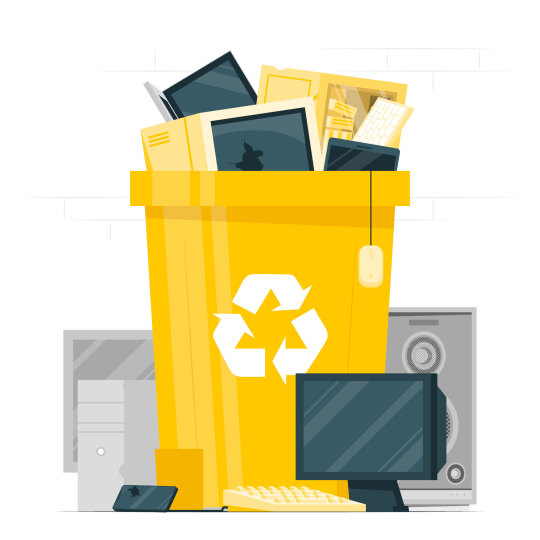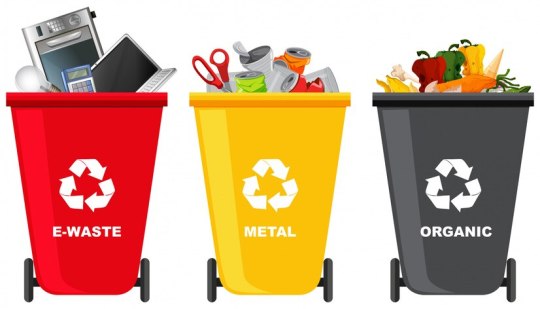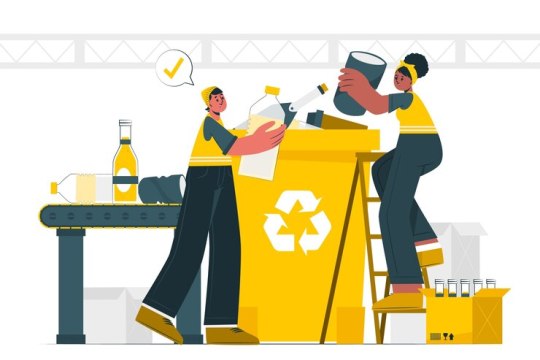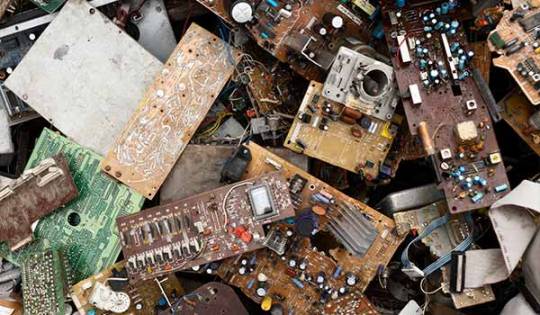Don't wanna be here? Send us removal request.
Text
The Importance of Electronic Waste Recycling: Protecting Our Planet and Health

Introduction
Electronic waste recycling is significant for shielding our planet and well-being. With the quick progression of innovation, the sum of disposed electronic gadgets, known as e-waste, has surged drastically. Appropriate administration of e-waste is fundamental to moderate its destructive impacts on the environment and human well-being. This article investigates the importance of reusing electronic scrap, tending to its natural and wellbeing impacts, the benefits of reusing, and mindful practices. By understanding the significance of electronic scrap recycling, we can contribute to a healthier planet.
Understanding Electronic Waste
E-waste refers to discarded electronic gadgets along with computers, smartphones, televisions, and different gadgets. As technology evolves, the lifespan of those devices shortens, leading to a growth in e-waste technology. Improper disposal of e-waste results in environmental degradation and health risks. Recognizing the character and scale of e-waste is the first step toward addressing its demanding situations. Effective e-waste disposal and electronic waste recycling are important to control this growing hassle sustainably.
Environmental Impact of E-Waste
The environmental impact of e-waste is profound and a long way-achieving. When electronic gadgets aren't recycled properly, they come to be in landfills, where toxic substances like lead, mercury, and cadmium can leach into the soil and water. This pollution damages ecosystems, contaminates water sources, and harms flora and fauna. Protecting the environment from the negative outcomes of e-waste requires complete electronic waste recycling packages. By recycling, we can save hazardous substances from polluting our planet and preserve treasured resources.
Health Risks of E-Waste
The health risks of e-waste are large, in particular for communities close to dumping websites. Exposure to toxic chemical substances in e-waste can cause intense health troubles, such as breathing troubles, neurological damage, and cancer. Children are in particular at risk of these dangers. Addressing the health dangers of e-waste includes promoting responsible e-waste practices and ensuring that e-waste is managed appropriately. By recycling e-waste nicely, we can lessen exposure to dangerous materials and protect public health.

Benefits of Electronic Waste Recycling
The benefits of electronic waste recycling extend beyond environmental safety. Recycling e-waste conserves herbal resources by converting valuable metals like gold, silver, and copper. This reduces the need for mining and lowers greenhouse gas emissions. Additionally, recycling electronic waste creates financial possibilities by generating jobs within the recycling and refurbishment industries. Embracing electronic waste recycling enables us to build a sustainable destiny by way of reducing pollution, protecting sources, and boosting the economy.
How to Recycle Electronic Waste
Recycling electronic waste includes numerous realistic steps. First, discover neighborhood waste recycling programs and drop-off locations. Many groups provide special collection activities for e-waste disposal. When recycling, make sure that statistics are securely erased from gadgets to guard personal information. Some producers and shops additionally offer take-away programs for antique electronics. By taking part in these packages, you could make sure that your e-waste is processed responsibly. Adopting responsible e-waste practices is key to powerful electronic waste recycling.
Final Words
In conclusion, electronic waste recycling is important for our planet and health. With information on the environmental impact of e-waste and the health risks of e-waste, we can admire the need for recycling electronic waste. The benefits of electronic waste recycling encompass resource conservation, pollution reduction, and an economic boom. Embracing Responsible E-Waste Practices guarantees that our discarded electronics are managed properly and sustainably. At Scrap Dost, we are committed to promoting effective e-waste control and assisting in shielding our surroundings for future generations. Additionally, we remember the fact that electronic waste isn't the best issue. We additionally deal with the wishes of every person with a scrap automobile. We pay for your scrap car based totally on the automobile make and offer a central authority-issued scrap certificate. This certificate, referred to as a Certificate of Deposit (COD), offers vast discounts on country and relevant authorities taxes while buying a brand new car. These CODs are traded on authorities' websites for sizable prices. Scrap Dost, purchases and promote those certificates, making sure that customers do not have to pay extra. By imparting complete answers for each e-waste and scrap motor, we contribute to defending the environment and selling accountable e-waste practices.
0 notes
Text
The Importance of Documentation in Bus Scrapping Services

Introduction to Bus Scrapping Services
Bus scrapping services play a pivotal role in the secure and proficient transfer of ancient and decommissioned buses. These administrations guarantee that buses are disassembled, reused, and arranged in an ecologically inviting way. Proper documentation is important in this process to maintain compliance with criminal and environmental policies. It enables the complete scrapping process from start to finish, making sure that each felony's necessities are met and that the scrapped substances are treated successfully. Scrapdost emphasizes the significance of accurate documentation to ensure a clean and transparent bus scrapping process.
Legal requirements for documentation
In the field of bus scrapping, compliance with legal documentation requirements is crucial.The local and national legislation requiring the scrapping of vehicles is established by regulation that mandates the provision of appropriate documentation. This includes proof of ownership, a decommissioning certificate, and a disposal record of hazardous materials. By ensuring that all necessary paperwork is completed and maintained, Scrapdost prevents the possibility of legal trouble and penalties. Proper documentation not only ensures compliance but also protects the interests of the service provider and the vehicle owner.
Documentation for the Ownership Transfer
When scrapping a bus, having good documentation is crucial to ensuring ownership transfers without difficulty. Once a bus is scrapped, ownership must be formally transferred to the scrapping service provider. This mandates particular paperwork, such as an ownership transfer form and a scraping certificate. Scrapdost manages this process carefully, ensuring all paperwork is correctly completed and submitted. Proper documentation avoids disputes, ensures ownership records are updated promptly, and allows for a clear and legal transfer of the vehicle.
Upholding records for financial and tax purposes
Proper documentation for bus scrapping services is also essential for financial management and tax reporting. Detailed records of the scrapping process, including expenditures, revenues, and any related transactions, are critical for proper financial reporting and taxation. Scrapdost keeps detailed records that promote financial transparency and aid with audits. By meticulously documenting the scrapping process, the organization assures that all financial elements are properly accounted for and in compliance with tax requirements.
Benefits of Comprehensive Documentation
The advantages of detailed documentation in are numerous. Comprehensive documentation benefits service providers like Scrapdost by increasing operational efficiency and accountability. It guarantees that each stage of the scrapping process is documented, lowering the possibility of mistakes and conflicts. Clients benefit from extensive documentation because it ensures that their car has been treated appropriately and follows all applicable legislation. This transparency builds confidence between service providers and clients, resulting in a more efficient and reliable scrapping process.

Limitations in Documentation and Solutions
Maintaining correct documentation in bus scrapping services might be challenging. Common challenges include missing records, paperwork loss, and monitoring the many stages of the scrapping process. Scrapdost responds to these difficulties by developing strong documentation management systems and best practices. Regular staff training, as well as the usage of digital record-keeping technologies, can assist in alleviating these concerns. Scrapdost proactively manages documentation to guarantee that all documents are comprehensive, correct, and easily accessible, allowing for a smooth scraping process.
Ensuring Accuracy in Documentation
Anyone with electronic scrap is our customer. We pay for electronic scrap according to its specifications. Furthermore, the central government has created a scrapping program that produces a scrap certificate, which provides large savings on state and central government taxes when acquiring electronic items. These certificates, known as Certificates of Deposit (COD), are even exchanged on the government website for $67,000. We pay for your e-scraps and give government scrap certifications. We also purchase and sell these certificates. The consumer is under no obligation to pay, and anybody may find a junk merchant online.
Potential Developments in Documentation for Bus Scrappage
As technology improves, the future of documentation in bus scrapping services is expected to undergo considerable changes. Digital technologies, such as blockchain and automated record-keeping systems, promise to improve the efficiency and security of documentation procedures. Scrapdost is continually investigating these advances to stay ahead of the curve. Implementing cutting-edge technology would not only simplify paperwork but also increase traceability and decrease mistakes. By embracing these future developments, Scrapdost hopes to continue delivering high-quality bus scrapping services with even greater accuracy and dependability, setting new industry benchmarks.
Conclusion
Finally, documentation is critical to providing good bus scrapping services. It maintains legal compliance, enables ownership transfers, promotes environmental protection, and assists with financial management. Scrapdost emphasizes the need for thorough documentation to ensure a clear, efficient, and compliant scrapping process. Scrapdost not only improves the quality of its services, but it also creates confidence with clients and regulatory agencies by guaranteeing that the scrapping process is conducted with the utmost professionalism and care.
0 notes
Text
Understanding the Scrap Recycling Process: From Collection to Reuse

The scrap recycling technique includes converting waste materials from a series to a single use. Scrap recycling is a critical commercial enterprise employer that transforms waste materials into treasured assets, protects herbal belongings, lowers power consumption, and minimizes environmental pollutants. This device encompasses numerous ranges, from the initial collection of scrap substances to their eventual reuse in several industries.
Right here’s a whole evaluation of the scrap recycling approach.
The first step in the scrap recycling technique is the collection of scrap substances. Those substances can come from a selection of properties, including families, organizations, the arrival of internet net web sites, and industrial organization company operations. Not unusual kinds of scrap embody metals (which include aluminum, copper, and steel), paper, plastics, glass, and electronics. Collection can be completed through curbside recycling applications, drop-off facilities, or purchase-decrease programs that provide incentives for returning recyclable materials.
The Process of Sorting Materials in Recycling Facilities
As soon as the scrap substances are gathered, they are transported to recycling facilities, where they'll be sorted. Sorting is an essential step that guarantees precise types of substances are separated for green processing. This can be completed manually or with computerized structures organized with magnets, sensors, and air classifiers. Metals are frequently sorted by using magnets to separate ferrous metals (like iron and steel) from non-ferrous metals (like aluminum and copper). Plastics are looked after with the useful aid of the use of kind and shade, while paper is separated into precise grades.
Processing After sorting
The materials go through processing to be prepared for recycling. Metals are usually shredded or beaten to lessen their length and facilitate melting. For instance, metallic is often shredded into small portions to make its masses much less complex to address and melt. Plastics are wiped away, shredded, and, from time to time, melted and pelletized to form uniform raw substances for the manufacturing of modern-day plastic products. Paper is pulped, which involves mixing it with water to break it down into fibers that would then be wiped clean and de-inked.

Melting and purification
Inside the melting and purification process, metals are melted in massive furnaces to eliminate impurities and put together for casting into new shapes. Every form of metal has its own private melting method: metallic is usually melted in an easy oxygen furnace or an electric-powered arc furnace, at the same time as aluminum is melted in a reverberatory furnace. The molten steel is then purified by removing any remaining contaminants. For plastics, purification consists of getting rid of non-plastic materials and contaminants over and over through washing or chemical strategies.
Production
The very last degree inside the recycling method is manufacturing, wherein the recycled materials are used to provide new products. As an example, recycled metallic and aluminum are used inside the automobile and manufacturing industries, just as recycled plastics are used in packaging, textiles, and consumer gadgets. Paper mills use recycled paper to deliver newsprint, cardboard, and business paper. This degree closes the recycling loop as products made from recycled materials re-input into the marketplace, reducing the need for virgin, uncooked substances.
Environmental and monetary blessings
The scrap recycling method offers huge environmental and monetary blessings. Recycling reduces the need for natural assets and protects raw substances like minerals, wood, and petroleum. It also saves electricity; for instance, recycling aluminum saves as much as ninety percent of the energy required to provide aluminum from raw ore. Furthermore, recycling reduces greenhouse gas emissions, decreases pollution, and minimizes the quantity of waste sent to landfills. Economically, the recycling corporation creates jobs and stimulates financial growth through the sale and purchase of recycled materials and products.
Forming as quickly as it is purified
The molten metal or plastic is powerful enough to just accept new shapes. Metals are sturdy into ingots, bars, or unique places of job artwork like vehicle components and production materials. Plastics are usually pellets or nicely molded into new products. Paper pulp is processed into new paper merchandise through a chain of drying and rolling steps. Glass is melted and reformed into bottles, jars, or unique glass products. The forming diploma is vital for transforming recycled materials into usable merchandise that meets the necessities of business employer agencies.
Conclusion
Scrap recycling is a critical part of sustainable, beneficial, and useful resource manipulation, converting waste into treasured substances that may be reused in numerous industries. From series and sorting to processing and manufacturing, every diploma plays a vital role in ensuring the overall performance and effectiveness of recycling efforts. By using facts and helping with the recycling approach, human beings and organizations can make a contribution to a more sustainable and environmentally fantastic future.
0 notes
Text
The Environmental Impact of Poor Scrap Management and How to Mitigate It

Introduction
The worldwide commercial and consumer panorama generates quantities of scrap substances, which consist of metals, plastics, paper, and digital waste. Bad scrap management can cause intense environmental effects, affecting ecosystems, human fitness, and contributing to climate change. Powerful mitigation strategies are vital to manipulating scrap sustainably, reducing environmental effects, and promoting a spherical economic device.
Environmental effects of bad scrap management
1. Pollutants of Land and Water in Our Bodies
Improperly disposed of scrap materials, especially electronic waste (e-waste), include risky substances like lead, mercury, and cadmium. These toxic elements can leach into soil and groundwater, contaminating drinking water resources and agricultural lands. Plastics, when not recycled, regularly emerge in landfills or water our bodies, leading to soil and water pollution. Microplastics from degraded plastic waste may be ingested with the aid of aquatic organisms, coming into the food chain and posing fitness"hazards"to the natural world and humans.
2. Air pollution
Incineration of scrap materials, mainly plastics and e-waste, releases dangerous gasses consisting of dioxins, furans, and exceptionally risky herbal compounds (VOCs) into the environment. Those pollutants contribute to air degradation and respiration troubles in people. Open burning of scrap materials, commonplace in regions with inadequate waste control infrastructure, similarly exacerbates air pollution and releases large amounts of carbon dioxide, a greenhouse gas.

3. Aid Depletion
Negative scrap manipulation practices often mean that valuable substances are misplaced rather than recycled. Metals like copper, aluminum, and unusual earth elements, which are finite and strength-extensive to mine, are wasted while no longer recovered from scrap. This depletion of natural belongings necessitates extra mining and extraction activities, which have their own non-public environmental impacts along with habitat destruction, soil erosion, and water infection.
4. Greenhouse Fuel Emissions
Inefficient scrap control contributes to improved greenhouse gas emissions. For example, the decomposition of natural waste in landfills produces methane, an effective greenhouse gas. The production of new merchandise from uncooked materials requires drastically more strength compared to the use of recycled substances. For that reason, terrible scrap control results in better strength intake and a larger carbon footprint.
Mitigation strategies
1. Enhancing recycling structures
Enhancing recycling infrastructure and systems is essential. This includes putting in greater recycling centers, improving series structures, and making sure the right sorting and processing of scrap substances. Governments and municipalities have to invest in advanced recycling technologies, which include automated sorting and processing machines, to improve growth performance and reduce contamination of recyclable substances.
2. Selling extended manufacturer duty (EPR)
EPR rules maintain manufacturers responsible for the entire lifecycle of their products, which incorporates submit-patron waste. This incentivizes them to layout products, which is probably easier to recycle and to take back their products at the end of their useful existence. Imposing EPR can extensively reduce"the quantity"of scrap entering landfills and promote the recycling and reuse of materials.
3. Public recognition and schooling
Elevating public recognition of the environmental effects of horrific scrap manipulation and the advantages of recycling is crucial. Instructional campaigns can encourage individuals and"organizations"to adopt higher waste control practices. faculties and offices need to be targeted with records on proper waste segregation, the importance of recycling, and a way to reduce waste.
4. Regulation and coverage Enforcement
More potent rules and enforcement mechanisms are needed to ensure compliance with waste control legal guidelines. Governments have to set up smooth recommendations for the disposal and recycling of numerous sorts of scrap materials. effects of illegal dumping and non-compliance with waste control guidelines want to be strictly enforced to deter environmentally risky practices.
5. Incentivizing Sustainable Practices
Economic incentives, on the side of tax breaks or subsidies for undertaking sustainable scrap control practices, can inspire greater effort to put money into recycling and waste reduction technologies. Programs that praise customers for returning recyclable substances, like deposit-refund structures for bottles and cans, can also increase recycling fees and decrease littering.
6. Advancing round economic device standards
Adopting a circular financial gadget approach includes designing merchandise for durability, reparability, and recyclability. It emphasizes the reuse, refurbishment, and recycling of materials to create a closed-loop machine. ought to innovate to lessen cloth use, boom product life cycles, and create new charge from waste materials through upcycling and remanufacturing.
Conclusion
Powerful scrap management is essential for mitigating environmental damage and promoting sustainability. By enhancing recycling structures, enforcing EPR, raising public reputation, enforcing hints, incentivizing sustainable practices, and advancing spherical financial system requirements, the negative effects of poor scrap manipulation may be substantially reduced. the ones that not only best defend the surroundings but additionally contribute to aid conservation and monetary resilience, fostering a healthier planet for future generations.
1 note
·
View note